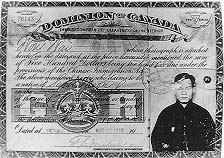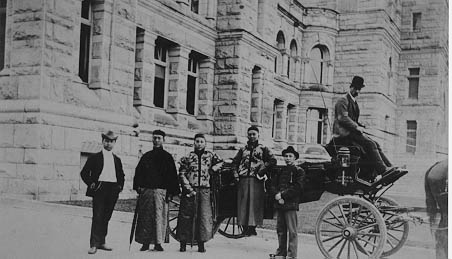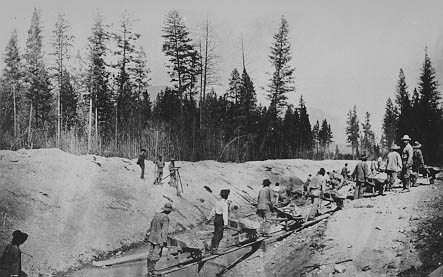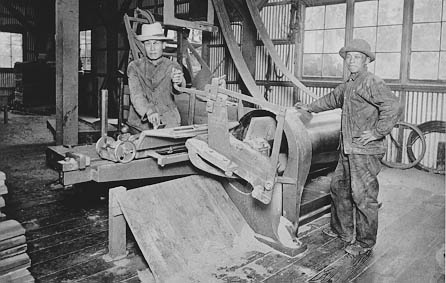 History of Chinese immigration:
four periods of migration at a glance
History of Chinese immigration:
four periods of migration at a glance
- the period of free entry (1858-84);
- the period of restricted entry (1885-1923);
- the period of exclusion (1924-47); and
- the period of selective entry, 1948 to present. (Lai
8)
- recent Taiwanese immigrants
 Beyond the Golden Mountain:
A Journey in Chinese-Canadian History
Beyond the Golden Mountain:
A Journey in Chinese-Canadian History
加拿大傳統的華僑一如美國,主要來自廣東省四邑 (台山、開平、恩平、新會 ),最早的一批開荒者可說是「苦力」。十九世紀中國農村的貧困和政治動亂,驅使青年農民出外謀生。起初以為苦幹三、五年可衣錦還鄉。但因交通不便,中國戰亂,加上美、加苛刻的移民法,華工多懷著團圓夢,在這塊富裕但排斥非白人的大陸上無奈地終老。?
第一批踏上「楓葉國」土地的華人是一八五八年由美國太平洋沿岸加州北上不列顛哥倫比亞省的淘金客。隨後二十年間抵達的華工,大都受僱建造橫跨該國的加拿大太平洋鐵路。一萬七千名築路華工,很多人因此罹難或傷殘。鐵路在一八八六年落成,遭遣散的部分華工在不列顛哥倫比亞省的維多利亞,今溫哥華附近留下,經營洗衣店,中國餐館或到白人家庭當傭工。另一些則東遷,散居各地。
(「華人在加開拓文明史料照片巡迴展」簡介)
As in America, early Chinese immigrants to Canada arrived mainly
from four counties in Canton Providence (Tai-shen, Kai-ping,
Ng-ping and Shin-hui). The earliest Chinese immigrants
were imported for their labour. Poverty and political
turbulence in China during the 19th century forced many young
farmers to go to Canada in search of a better life. At
first, they expected to return to their hometowns after 2 to
3 years of hard work. However, the inconvenient transportation
and continuing civil war in China made it impossible.
In addition, Canada's strict "anti-Chinese" legislation prevented
most families of Chinese immigrants from joining them in Canada.
In the end, most early Chinese settlers stayed until their death
in this rich but often unwelcoming country.
As a result of the gold rush, the first Chinese immigrants
arrived in "Maple Leaf country" in 1858 along the west coast.
Most of them settled in British Columbia. Twenty years
later, there was a large scale influx of Chinese for construction
work on the final section of the Canadian Pacific Railway.
As many as 17,000 Chinese labourers came to Canada and many
lost their lives or were injured during the construction period.
After the railroad was completed, some Chinese workers stayed
in Victoria and Vancouver to open laundries or restaurants,
while others moved to eastern parts of Canada. While early
Chinese immigrants came to Canada as labourers to earn
their living, today's Chinese immigrants follow a very different
pattern. Most Chinese from Taiwan, Hong Kong and Mainland
China have moved to Canada for investment opportunities,
better education and living conditions, or as a reaction to
1997.
|
 Taiwanese immigrants: Yearly Amount of People Accepted
Taiwanese immigrants: Yearly Amount of People Accepted
1990-3900; 1991-6400; 1992-7900; 1993-10,000; 1994-7500;
1995-7200
¡@
1995 Family class--650
Skilled worker 3,200
Business class --3,300 (investor, entrepreneurs, self-employed)
Retired (abolished category) 40
live-in caregiver 4
¡@
|
 History
of Chinese immigration:
Important Dates & Development History
of Chinese immigration:
Important Dates & Development
- January 1788-- fifty Chinese artisans and sailors
disembarked at Nootka Sound. The Chinese carpenters with the
assistance of the native Indians built a two-storey house
and a forty ton schooner called North West America,
hte first sea-worthy ship constructed in that area. Some of
the Chinese workers were assimilated by the Northwest Coast
Indians. (Lee 17 )
the period of free entry (1858-84)
- the late 1850's--the discovery of gold in the Fraser
River
- Between 1880 and 1885 about 16,000 Chinese railroad
workers were engaged on the railroad construction
project. They spread out from various work camps along
the railroad line working like an army of ants. (Lee
59 )
- reasons for contract laborers
- Not only did the fabulous tales of the Gold Rush
attract the poverty-stricken Chinese but at the same time,
the colonizers were aware there was a need to replace the
source of cheap labor lost by the abolition of the slave
trade. The "time had (now) come for yellow to take the place
of black at the behest of antislavery sentiment" and initiated
the notorious system of the Chinese coolie trade. (Lee
17)
the period of restricted entry (1885-1923):
anti-Chinese movements+ nativism
- 1904--500-dollar head tax
the period of exclusion (1924-47)
The post-war recession and high unemployment as a result of
demobilization touched off another wave of anti-Chinese sentiment.
Labor unions called for a post-war immigration policy: during
the reconstruction period there should be a more restrictive
Chinese immigration legislation. ... (Lee
131)
In the early 1920's the opium issue and the general fear arising
from the perception that Chinese Canadians were no longer satisfied
with their unskilled labor status combined with the foreseeable
entrance of Chinese Canadians into professional and big business
enterprises caused a panic in the minds of nativists. Chinese
Canadians who decided to remain in the country had broken the
myth that they were sojourners. All these compound the root
of what later became known as the yellow peril phobia.
In order to prevent an imaginable war "between the Oriental
and the Euro-Canadian for possession of British Columbia," nativists
confided that the only way to stop the illusory Chiense Canaidan
threat was to "handicap him, hamper him, restrict him
as far as possible, put him out of the industrial and commerical
running." ¡
剪他的羽翼,牽制他的發展,儘可能約束他,並使他無從在各行各業展開競爭」Lee133)
the period of selective entry, 1948
to present.
The repeal of the Chinese Exclusion Act of 1923 in 1947
gave little improvement toward Chinese immigration as the regulations
governing Asian immigration were still applicable to Chinese.
No Chinese, except those who were wives and children under 18
years of age of Canadian citizens, were allowed to land in Canada.
The revocation of these regulations in 1956 was the first time
the Canadian government unravelled its immigration law toward
s Chinese-Canadian community. In early 1962 the federal government
further amended the immigration regulations. Discriminatory
racial wording which appeared in the preceding regulations were
removed. (Lee169¡^
¡@
|
 High Hope and Harsh Reality:
High Hope and Harsh Reality:
Pictures of Early Chinese
immigrants as Contract Laborers
From "Beyond The Gold Mountain" Exhibition, 1997

1913 Chinese Headtax Certificate
Courtesy Barkerville Historical
Town, Barkerville |
|

¦bºû¦h§Q¨È¬Ùij·|®Ç²±¸Ë©ç·Ó
(¨õ¸Ö¬ÙÀÉ®×À]´fÉ)
|
 µØ¤u¦b¤sÀ¤¤«Ø¥[®³¤j¤Ó¥¬vÅK¸ô
¤@¤K¤K¥|¦~ (¥[®³¤j°ê®aÀÉ®×À]´fÉ) µØ¤u¦b¤sÀ¤¤«Ø¥[®³¤j¤Ó¥¬vÅK¸ô
¤@¤K¤K¥|¦~ (¥[®³¤j°ê®aÀÉ®×À]´fÉ)
|
- Fish Cannery and Other Workers:
 ¦bSweeney CooperageªO¼t¤u§@ªºµØ¤H
¬ù¤@¤E¤@¤T¦Ü¤@¤E¤@¤¦~
(ºû¦h§Q¨È¥«ÀÉ®×À]´fÉ)
¦bSweeney CooperageªO¼t¤u§@ªºµØ¤H
¬ù¤@¤E¤@¤T¦Ü¤@¤E¤@¤¦~
(ºû¦h§Q¨È¥«ÀÉ®×À]´fÉ)
|
 Relevant Links:
Relevant Links:
|
References & Acknowledgments:
- Lai, David Chuenyan. Chinatowns: Towns
Within Cities in Canada. Vancouver: University of BC P, 1988.
- ¡uµØ¤H¦b¥[¶}©Ý¤å©ú¥v®Æ·Ó¤ù¨µ°j®i¡v²¤¶.
¡}Beyond The Gold Mountain: A Journey in Chinese-Canadian History,
1997¡^. ¥D¿ì³æ¦ì¡G°ê¥ß¾ú¥v³Õª«À]¡B¥[®³¤j¤å©ú³Õª«À]¡B¥[®³¤j¾n¥x¥_¶T©ö¿ì¨Æ³B,
April-June, 1997¡C
- Lee, Wai-man. Portraits of
a Challenge: An Illustrated History of the Chinese Canadians.
Council of Chinese Canadians in Ontario, 1984.
Special Thanks to --
Canadian Museum of Civilization and
The Canadian Trade Office in Taipei for
providing the information and the precious photographs on this page.
·PÁÂ¥[®³¤j¤å©ú³Õª«À]©M¥[®³¤j¾n¥x¥_¶T©ö¿ì¨Æ³B´£¨Ñ¸ê®Æ¡C
background: ¦b«ØÅK¸ô
(¨õ¸Ö¬ÙÀÉ®×À]É)
|